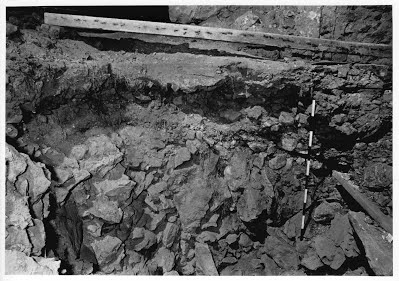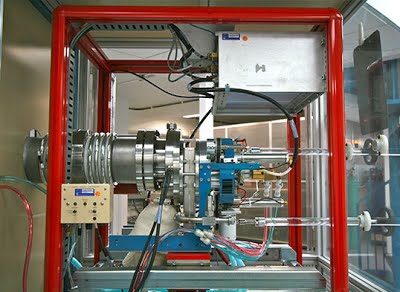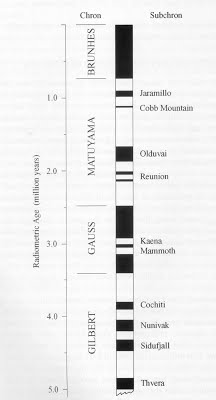Until the 1930s, information contained within cave sediments was thought to be limited to just:
-
Archaeological deposits such as animal and human remains.
-
Information gleaned by visual examination of the stratigraphy of sedimentary layers. This can determine depositional environment, sediment origin, relationship of sediments to cave or landscape development, long-term depositional or erosion trends, and relationships of fossils or artifacts to cave processes.
Then in 1940 it was discovered that the rate of decay of a radioactive isotope of carbon (Carbon-14) could be used to provide ages for organic samples such as bone, charcoal, etc.
Over the last 30 years or so however, the study of cave sediments has become a hot scientific research topic. Several new dating techniques have shown that sediments can now be used to assess a caves geological history (speleogenesis) and age. The newest techniques include:
-
Uranium/Thorium (U/Th) dating of speleothems
-
Paleolmagnetic Chronology dating of sediments
-
Cosmogenic Isotope Dating of sediments
Such methods can provide a geomorphic record of cave ages and river system evolution over the past 5 million years. These methods also offer potential implications for the evaluation of current concern over global warming.
Although the techniques are normally beyond the pocket of the average caver, this brief description might serve as an introduction to the subject. “Sediments are archives of critically important paleoclimatic information….. and are the unopened history book of the Pleistocene” (White 2007).

…................................................................................
The two broad categories of sediments:
-
Clastic sediments: Sediments composed of particles eroded from rocks and later deposited. They can reflect the hydraulics of the flow system that deposited them, although any data gained lacks detail and can only provide broad minimum or maximum dates. The most common clastic sediments are stream-transported (mechanically moved) sediments.
-
Chemical sediments. Carbonate speleothems have the greatest information content as they are deposited from solution and thus carry a record of texture, mineralogy, trace element content and isotope content. Dated speleothems can provide a micro-stratigraphy with a very high time resolution, particularly those having uniform growth rates over long time periods.
The two broad categories are sub-divided as follows…...
Clastic sediments
A) Autochthonous sediments: Composed of particles eroded from cave walls and later deposited within the same cave.
-
Weathering detritus (i.e. frost damage inside cave entrances)
-
Breakdown (i.e. roof collapse)
-
Guano
B) Allochthonous sediments (materials transported into a cave from outside)
-
Entrance talus (including archaeological deposits)
-
Infiltrates: a) Soil washdown; b) Gravitational debris
-
Stream transported sediments: a) Organic in-wash; b) Alluvial sediments; c) Glacial in-wash; d) Volcanic in-wash
-
Debris flows
-
Aeolian deposits (blown into caves by wind action), such as sand and pollen
Chemical sediments
-
Travertine: a) Flowstone; b) Dripstone (and possibly ‘moonmilk: a hydrated magnesium carbonate)
-
Evaporites: i) Crusts (such as tufa which also contains paleoclimate records) and, ii) Bulk deposits
-
Phosphates
-
Resistates
-
Ice
Other types of sediments can also be found in caves such as bat guano, dried mud floors, mineral deposits (iron, manganese etc), and
marine deposits can sometimes be found
at the entrances to what were once sea caves.
….............................................................................................
The four main dating techniques:
1. Radiocarbon dating (or C14 dating)
Radiocarbon, or carbon 14, is an isotope of the element carbon that is unstable and weakly radioactive. The stable isotopes are carbon 12 and carbon 13. Carbon 14 is continually being formed in the upper atmosphere by the effect of cosmic ray neutrons on nitrogen 14 atoms. It is rapidly oxidized in air to form carbon dioxide and enters the global carbon cycle.
Plants and animals assimilate carbon 14 from carbon dioxide throughout their lifetimes. When they die, they stop exchanging carbon with the biosphere and their carbon 14 content then starts to decrease at a rate determined by the law of radioactive decay.
Radiocarbon dating is essentially a method designed to measure residual radioactivity. By knowing how much carbon 14 is left in a sample, the age of the organism when it died can be known. It must be noted though that radiocarbon dating results indicate when the organism was alive but not when a material from that organism was used.
(Source: http://www.radiocarbon.com/about-carbon-dating.htm)
Radiocarbon Datable Materials
Not all materials can be radiocarbon dated. Most, if not all, organic compounds can be dated. Some inorganic matter, like a shell’s aragonite component, can also be dated as long as the mineral’s formation involved assimilation of carbon 14 in equilibrium with the atmosphere.
Samples that have been radiocarbon dated since the inception of the method include charcoal, wood, twigs, seeds, bones, shells, leather, peat, lake mud, soil, hair, pottery, pollen, wall paintings, corals, blood residues, fabrics, paper or parchment, resins, and water, among others.
Physical and chemical pre-treatments are carried out on these materials to remove possible contaminants before they are analyzed for their radiocarbon content.
Radiocarbon dating can be used
reliably
to date items between the ages of 6,000 to 50,000 years.

(Source: http://www.radiocarbon.com/about-carbon-dating.htm)
2. U/Th dating of speleothems
Uranium/Thorium dating is currently the most effective method of dating speleothems: A common uranium isotope undergoes a long and complicated decay chain before reaching a stable isotope. Along that chain are two long-lived isotopes (the uranium isotope with a half life of 248,000 years and the thorium of 75,200 years. Measurement of the ratio between them allows a calculation of an age. What makes U/Th isotope dating particularly useful for calcite speleothems is a quirk in the geochemistry of these two elements. As a result, speleothems often contain tens to hundreds of parts per million uranium but no thorium. The radiogenic thorium that accumulates in the calcite is a direct measure of the time elapsed since the calcite was deposited.
The process requires taking samples (a few milligrams) from a speleothem, and the use of accelerator mass spectroscopy to measure isotope concentrations and is useful for ages up to 600,000 years; the theoretical limit of the process.
Many other techniques have been used for speleothem dating, such as obtaining oxygen isotope ratios, carbon isotope ratios, trace elements, examining colour banding, luminescence banding etc..
3. Paleolmagnetic Chronology dating
The earths magnetic field reverses at regular intervals during which the magnetic north pole and magnetic south pole exchange places. This phenomenon has been studied in detail and a geomagnetic stratigraphy has been established back into geologic time, the period most relevant to cave formation being the last 5 million years.
Fine grained clastic sediments contain small amounts of magnetic minerals such as magnetite and hematite. As these sediments settle (during deposition in flooded caves), the magnetic grains rotate to align with the earth’s magnetic field at the time and the magnetic orientation is locked in. This is called detrital remanent magnetism (DRM). The orientated minerals also have an up-down component, and align with the magnetic inclination (the angle of dip below horizontal). Once the grains have settled, their magnetic orientation is locked in place. By taking a bulk sample and recording its present-day orientation using a compass, the magnetic grains can later be analysed. A highly sensitive magnetometer is required as the sample may only contain very few magnetic grains, and these will have extremely weak magnetic fields.
If paleomagnetic reversals can be identified in cave sediments, they provide time markers and thus dates for sediments and the passages in which they occur. Because of the long time spans between reversals, the method is best applied to tiered caves where the total sequence of cave passages and their sediments represent equally long times. The best samples are obtained from a passages slack water areas where sediment grains settle out in quiet water.
The
magnetostratigraphic timescale below shows the orientation of the
magnetic field at different times in the earth's history (Periods
when the fields were reversed are shown in white).......

(Source:
Sasowsky, Ira D. “Paleomagnetic Record in Cave Sediments”,
in Encyclopedia of Caves (2005) by Culver & White, page 428.
Interpretation
This is the tricky bit: The magnetostratigraphic timescale is a binary one – it only shows normal or reverse. If we have an isolated sample of cave sediment that has normal polarity, how can we know which normal interval (chron) it came from? In short, we can't; at least not with absolute certainty. But we can make an educated guess. For example, if we find a reversed polarity sample, we know that it must be at least 780,000 years old (the end of the last reversed interval, known as the Matuyama chron). Likewise if we find an isolated deposit of normal polarity sediment, we infer that it must be either less than 780,000 years old or more than 990,000 years old. Using these constraints, in context with other information such as U/Th dates of speleothems or position of the landscape, we can narrow down the age of a cave. (Source: Sasowsky, Ira D. “Paleomagnetic Record in Cave Sediments”, in Encyclopedia of Caves (2005) by Culver & White, page 429.
4. Cosmogenic Isotope Dating
The earth is under constant bombardment by cosmic rays, which are extremely energetic particles from space. These particle streams and their spallation products from collisions in the upper atmosphere, rain down on the surface where they can induce nuclear reactions in surface materials. These reaction products are known as cosmogenic isotopes and can be used as an interpretative tool. Two particular isotopes are used; beryllium with a half life of 2.18 million years, and aluminium, with a half life of 1.02 million years. Very tiny concentrations of these isotopes can build up in surface quartz pebbles or sand. If these are then washed underground, they are shielded from cosmic rays, and the accumulated Be and Al will begin to decay. Although the initial concentrations of cosmogenic isotopes are not known, the ratio of concentrations will change so that the time spent underground can be calculated. Because concentrations are measured in millions of atoms, an accelerator mass spectrometer is needed to determine the isotope ratios. Cosmogenic isotope dating is one of the most promising recent techniques and covers a timescale dating back 5 million years, which is the time scale for most active karst systems. The quartz that is dated is part of the channel facies sediment load and these materials are usually deposited when the cave passage is part of the active drainage system. The cosmogenic date of the sediment provides a minimum age of the cave passage.
....................................................................................................
Cave deposits in North Wales - A final word
North Wales contains over 200 caves. Many more await future discovery. Most of the areas caves contain deposits in abundance. Caves such as Ogof Hesp Alyn was formed below the water table, and having its original resurgence at a high point in the cave system, contains countless tons of aggraded deposits suitable for paleomagnetic or cosmogenic dating. The other large cave systems contain a multitude of deposit types just waiting to be analysed. Despite the Victorian popularity of cave archaeology, we are also now finding that many known archaeological caves still contain undisturbed deposits, and many other caves have never been assessed for their archaeological potential. Despite this promising potential, the only caves that now attract the interest of modern-day professionals are those containing the oldest known archaeological deposits, such as Pontnewydd Cave and Ffynnon Bueno Cave.
In practice, there are two constraints to future work on cave sediments:
1. Cave archaeology has become so time-consuming and technically challenging that actual excavation is now rarely carried out.
2. Techniques such as paleomagnetic or cosmogenic dating requires highly sensitive equipment, and numerous samples need to be tested. Hence the cost tends to be prohibitive.
Although the science now exists to extract enormous amounts of data from cave
deposits, very little actual analysis is carried out on grounds of cost. There is
therefore a real need to establish some form of planned programme aimed at
examination of cave deposits in North Wales and beyond.
August 2016
…................................................................................................
Glossary
Aeolian: Wind blown
Allochthonous sediments: Those comprising materials transported into a cave from outside.
Autochthonous sediments: Those comprising materials that originated within a cave.
Clastic sediments: Sediments composed of fragments of older rocks.
Facies: An area of sediment whose characteristics indicate how it was deposited.
Spallation (in a cosmogenic context): the break-up of a bombarded nucleus into several parts.
Speleogenesis: The history of a caves original formation and its subsequent development.
Talus: Rock fragments at the base of a cliff.
….................................................................................................
Further reading
Most of the information on this page has been taken
from William White’s “Cave Sediments and
Paleoclimate” (See links below).
General
Cave Sediments and Paleoclimate (2007) by William B. White: https://caves.org/pub/journal/PDF/v69/cave-69-01-76.pdf .
Sediments in Caves
(2002) by Trevor Ford. BCRA Cave Studies Series No. 9. 32 page booklet. Possibly the best introduction to the subject.
Studies in Cave Sediments (2007): https://books.google.co.uk/books?id=aGiMMzseW2YC&pg=PA178&lpg=PA178&dq=U/Th+dating+of+speleothems&source=bl&ots=8fZPP1Dh84&sig=9iKMBC_QIHVEQTnWcPa7lwS-k30&hl=en&sa=X&ved=0ahUKEwijg7_qr6XOAhViAsAKHeUKDvc4FBDoAQgrMAI#v=onepage&q=U%2FTh%20dating%20of%20speleothems&f=false
Comparison of U–Th, paleomagnetism, and cosmogenic burial methods for dating caves: Implications for landscape evolution studies : http://geomorphology.sese.asu.edu/Papers/Stock_et_al_EPSL_05_2.pdf
Clastic Sediments in Caves - Imperfect Recorders of
Processes in Karst
:
http://ojs.zrc-sazu.si/carsologica/article/viewFile/216/205
Radiocarbon dating
Basic principles: http://www.radiocarbon.com/about-carbon-dating.htm
U/Th dating:
White paper on Speleothem based climate proxy records: https://www.ncdc.noaa.gov/paleo/reports/trieste2008/speleothems.pdf
Paleomagnetic Chronology dating
Paleomagnetic and Archaeomagnetic Dating: (the basics) http://www.anth.ucsb.edu/faculty/stsmith/classes/anth3/courseware/Chronology/11_Paleomag_Archaeomag.html
Sedimentology and Paleomagnetism of Sediments, Kartchner Caverns, Arizona: https://caves.org/pub/journal/PDF/V61/v61n2-Hill-Sedimentology.pdf
Cosmogenic Isotope Dating
Cosmogenic Nuclide Analysis: http://www.geomorphology.org.uk/sites/default/files/geom_tech_chapters/4.2.10_CosmogenicNuclideAnalysis.pdf
Cosmogenic nuclide burial dating of hominin-bearing Pleistocene cave deposits at Swartkrans, South Africa (available on Academia, which requires free registration): http://www.academia.edu/9570724/Cosmogenic_nuclide_burial_dating_of_hominin-bearing_Pleistocene_cave_deposits_at_Swartkrans_South_Africa
An Isochron Method for Cosmogenic-Nuclide Dating of Buried Soils and Sediments: http://noblegas.berkeley.edu/~balcs/pubs/Balco_Rovey_AJS_2008.pdf
Further general printed source:
Culver & White (eds)
(2005)
Encyclopedia of Caves ISBN: 0 12 406061 7